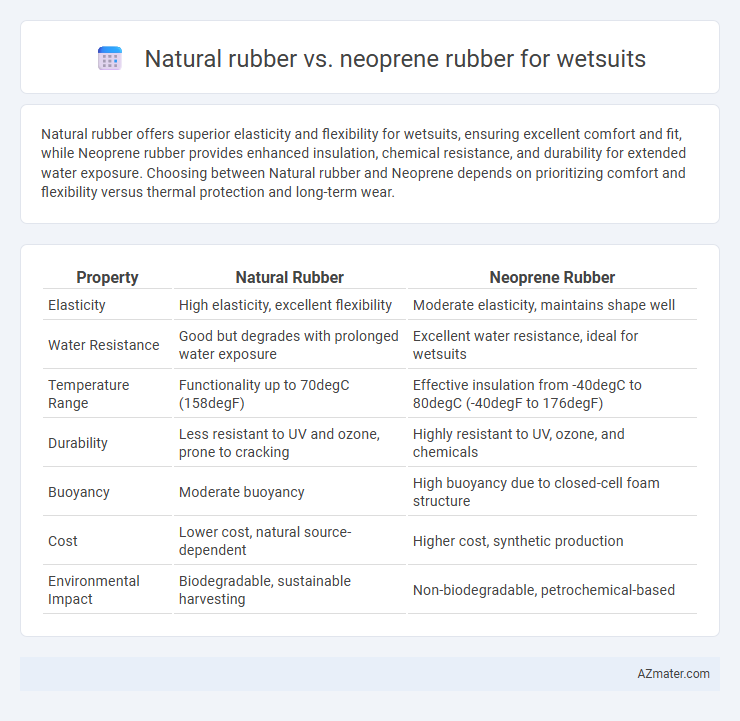Natural rubber offers superior elasticity and flexibility for wetsuits, ensuring excellent comfort and fit, while Neoprene rubber provides enhanced insulation, chemical resistance, and durability for extended water exposure. Choosing between Natural rubber and Neoprene depends on prioritizing comfort and flexibility versus thermal protection and long-term wear.
Table of Comparison
| Property | Natural Rubber | Neoprene Rubber |
|---|---|---|
| Elasticity | High elasticity, excellent flexibility | Moderate elasticity, maintains shape well |
| Water Resistance | Good but degrades with prolonged water exposure | Excellent water resistance, ideal for wetsuits |
| Temperature Range | Functionality up to 70degC (158degF) | Effective insulation from -40degC to 80degC (-40degF to 176degF) |
| Durability | Less resistant to UV and ozone, prone to cracking | Highly resistant to UV, ozone, and chemicals |
| Buoyancy | Moderate buoyancy | High buoyancy due to closed-cell foam structure |
| Cost | Lower cost, natural source-dependent | Higher cost, synthetic production |
| Environmental Impact | Biodegradable, sustainable harvesting | Non-biodegradable, petrochemical-based |
Introduction to Wetsuit Materials
Natural rubber offers excellent elasticity and superior comfort for wetsuit construction, making it a preferred choice for flexibility and close body fit. Neoprene rubber provides enhanced thermal insulation and durability, crucial for maintaining body warmth in cold water environments. Both materials are essential in wetsuit manufacturing, with natural rubber prioritizing flexibility and neoprene optimizing insulation and resistance to wear.
What is Natural Rubber?
Natural rubber, derived from the latex sap of the Hevea brasiliensis tree, is valued for its exceptional elasticity, flexibility, and water resistance, making it a preferred material in wetsuit manufacturing. Unlike synthetic alternatives like neoprene, natural rubber offers superior biodegradability and a lower environmental impact. Its ability to provide excellent insulation and durability in aquatic conditions enhances performance and comfort for divers and surfers.
What is Neoprene Rubber?
Neoprene rubber is a synthetic elastomer widely used in wetsuits due to its excellent insulation, flexibility, and resistance to water, oils, and UV rays. Unlike natural rubber, neoprene maintains its properties in wet and cold environments, providing superior thermal protection and durability for divers and surfers. Its closed-cell foam structure traps air, enhancing buoyancy and comfort, making it the preferred material for modern wetsuits.
Key Differences Between Natural Rubber and Neoprene
Natural rubber offers superior elasticity, biodegradability, and comfort, making it ideal for wetsuits requiring high flexibility and environmental sustainability. Neoprene rubber provides enhanced chemical resistance, thermal insulation, and durability against abrasion, preferred for wetsuits used in harsher marine conditions. Key differences lie in natural rubber's renewable origin and breathability, versus neoprene's synthetic composition with better resistance to oils, UV rays, and colder water temperatures.
Environmental Impact and Sustainability
Natural rubber wetsuits, derived from latex sap of rubber trees, offer a renewable and biodegradable alternative with lower carbon emissions during production compared to neoprene. Neoprene rubber, a synthetic material made from petrochemicals, involves energy-intensive manufacturing processes and generates non-biodegradable waste that contributes to pollution. Selecting natural rubber wetsuits supports sustainable forestry practices and reduces reliance on fossil fuels, enhancing overall environmental benefits.
Comfort and Flexibility
Natural rubber wetsuits offer superior elasticity and breathability, providing enhanced comfort and a snug, glove-like fit that adapts to body movements. Neoprene rubber, while less flexible, retains better insulating properties and durability, making it suitable for colder water but often feeling stiffer and less comfortable during extended use. The choice between natural rubber and neoprene hinges on balancing the need for flexibility and comfort against thermal insulation and longevity.
Durability and Longevity
Natural rubber offers excellent elasticity and comfort for wetsuits but tends to degrade faster due to UV exposure, ozone, and saltwater, leading to reduced durability and shorter lifespan. Neoprene rubber provides superior resistance to environmental factors like UV rays, chemicals, and abrasion, ensuring enhanced durability and prolonged longevity in harsh aquatic conditions. For long-term wetsuit performance, neoprene is the preferred material due to its robust durability and extended service life.
Thermal Insulation and Performance
Natural rubber offers excellent elasticity and breathability, which contributes to superior comfort but has moderate thermal insulation compared to neoprene. Neoprene rubber excels in thermal insulation due to its closed-cell foam structure, effectively trapping heat and providing better warmth retention in cold water conditions. Performance-wise, neoprene maintains flexibility and durability under varying temperatures, making it the preferred choice for wetsuit applications requiring enhanced thermal protection and long-lasting wear.
Price and Market Availability
Natural rubber wetsuits tend to be more expensive due to their eco-friendly sourcing and limited production scale, while neoprene wetsuits offer a more affordable option with widespread availability. Neoprene dominates the market with mass production and diverse product ranges, making it easier to find in various price brackets and retail outlets. Price sensitivity and accessibility make neoprene the preferred material for most consumers seeking wetsuits.
Choosing the Right Wetsuit Material
Choosing the right wetsuit material depends on factors such as flexibility, durability, and water resistance. Natural rubber offers excellent elasticity and comfort but lacks the same level of chemical resistance and UV protection compared to neoprene rubber. Neoprene is preferred for wetsuits due to its superior insulation, resistance to oils and sunlight, and enhanced durability in marine environments.

Infographic: Natural rubber vs Neoprene rubber for Wetsuit
 azmater.com
azmater.com